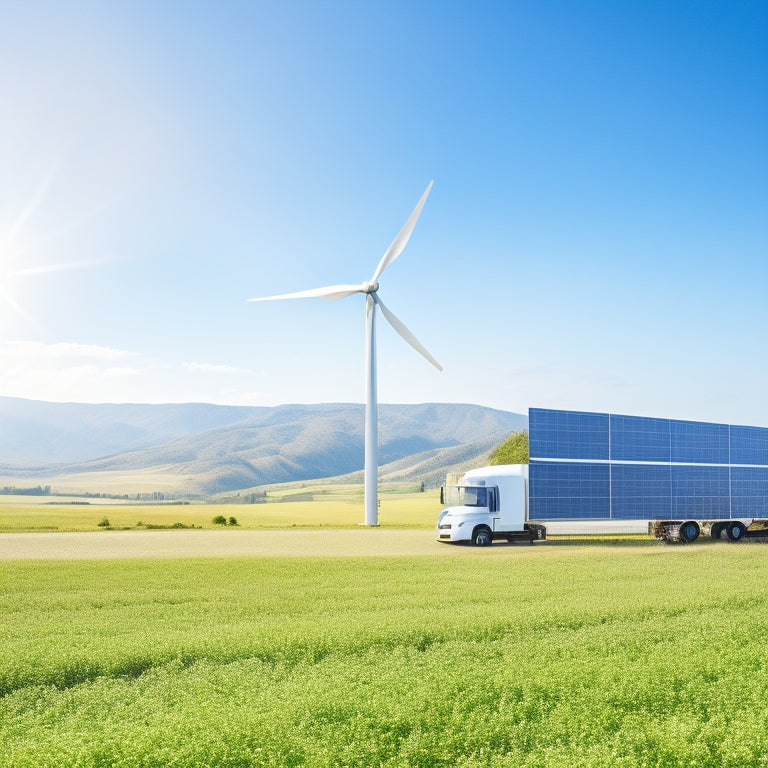
Why Fleet Owners Invest in Renewable Energy Systems
Share
As you consider investing in renewable energy systems for your fleet, you're likely driven by the desire to reduce your dependence on fossil fuels and mitigate the risks of price volatility. By doing so, you can lower your operating expenses over time and increase financial stability. Plus, government incentives can help offset the upfront costs. Renewable energy systems can also improve fleet efficiency and productivity while supporting eco-friendly goals. You're taking an essential step towards a more sustainable future, and understanding the ins and outs of renewable energy systems will reveal even more benefits waiting to be uncovered.
Key Takeaways
• Fleet owners invest in renewable energy systems to reduce reliance on fossil fuels and decrease carbon emissions, mitigating environmental impact.
• Renewable energy systems lower operating expenses over time, increasing financial stability through cost savings and reducing price volatility risks.
• Government incentives, such as tax credits and grants, offset upfront costs, making renewable energy adoption more accessible to fleet owners.
• Renewable energy systems improve fleet efficiency and productivity by reducing fuel consumption, improving fuel economy, and increasing safety.
• Investing in renewable energy systems helps fleet owners meet emissions and sustainability goals, enhancing their reputation and contributing to a more sustainable supply chain.
Reducing Dependence on Fossil Fuels
As fleet owners aim to reduce their carbon footprint, they're turning to renewable energy systems to decrease their reliance on fossil fuels, which have dominated the industry for decades.
You, as a fleet owner, know that this shift is vital for energy security and fuel diversification. By investing in renewable energy, you're not only reducing your carbon emissions but also mitigating the risks associated with price volatility and supply chain disruptions.
Environmental Benefits of Solar Power
By incorporating solar power into your renewable energy strategy, you can greatly reduce greenhouse gas emissions and mitigate the environmental impact of your fleet operations. As a fleet owner, you have a significant role to play in reducing your carbon footprint and promoting eco-friendliness. Solar power, a form of green energy, offers a sustainable living solution that aligns with your environmental goals.
Here are some key environmental benefits of solar power:
-
Reduces air pollution: Solar power generates electricity without emitting pollutants, making it a cleaner alternative to fossil fuels.
-
Conserves water: Solar power requires minimal water usage, unlike traditional power plants that consume large amounts of water.
-
Minimizes waste: Solar panels produce no hazardous waste, reducing the risk of environmental contamination.
- Supports biodiversity: Solar panels can be designed to accommodate local ecosystems, preserving natural habitats and promoting biodiversity.
Reducing Operating Expenses Long-Term
Installing solar power systems can noticeably reduce your fleet's operating expenses over time, allowing you to allocate resources more efficiently and increase your bottom line. By generating your own clean energy, you can substantially decrease your reliance on non-renewable energy sources and lower your energy costs. This reduction in energy expenditures can have a direct impact on your fleet's profitability.
Implementing cost savings strategies, such as investing in solar power, can help you achieve long-term financial stability. With predictable energy costs, you can better plan for the future and make informed financial decisions.
Financial planning tools, like cost-benefit analyses and return on investment (ROI) calculations, can help you quantify the benefits of renewable energy systems and make data-driven decisions.
Government Incentives for Fleet Owners
You can greatly benefit from various government incentives specifically designed to encourage the adoption of renewable energy systems among fleet owners. These incentives can substantially offset the upfront costs associated with investing in renewable energy systems, making it more feasible for you to move towards a more sustainable fleet operation.
Some of the government incentives you can take advantage of include:
-
Tax credits: Claim a percentage of your renewable energy system's cost as a credit against your tax liability, reducing your tax burden.
-
Grant applications: Apply for grants specifically designed for fleet owners adopting renewable energy systems, providing additional funding for your project.
-
State and local incentives: Take advantage of state and local government incentives, such as rebates, property tax exemptions, and sales tax exemptions.
- Low-interest loans: Access low-interest loans or financing options to help fund your renewable energy system installation.
Increased Fleet Efficiency and Productivity
As you invest in renewable energy systems, you'll notice significant improvements in your fleet's efficiency and productivity. By reducing fuel consumption, you'll lower your operating costs and minimize your carbon footprint.
Optimized vehicle performance will also enable you to complete tasks more quickly and effectively, freeing up resources for other important tasks.
Reduced Fuel Consumption
By integrating renewable energy systems, fleet owners can greatly decrease fuel consumption, thereby increasing their fleet's efficiency and productivity. This reduction in fuel consumption is made possible by leveraging fuel savings strategies that optimize fuel efficiency metrics.
You can expect significant reductions in fuel costs, which can have a direct impact on your bottom line.
Some key benefits of reduced fuel consumption include:
-
Improved fuel economy: By reducing fuel consumption, you can increase your fleet's miles per gallon, reducing the amount of fuel needed to complete tasks.
-
Lower emissions: Decreased fuel consumption translates to reduced greenhouse gas emissions, contributing to a cleaner environment.
-
Increased safety: With reduced fuel consumption, you're less likely to encounter accidents caused by reckless driving or fuel-related issues.
- Enhanced fleet reputation: By adopting eco-friendly practices, you can enhance your fleet's reputation and appeal to environmentally conscious customers.
Optimized Vehicle Performance
Fleet owners who integrate renewable energy systems can optimize vehicle performance, thereby increasing fleet efficiency and productivity. By leveraging Vehicle Analytics, you can gain valuable insights into your fleet's performance, identifying areas for improvement and opportunities for optimization. This data-driven approach enables you to fine-tune your vehicles, ensuring they operate at peak performance.
Through Performance Tuning, you can calibrate your vehicles' systems to maximize efficiency, reducing energy waste and minimizing downtime. With optimized performance, your fleet can cover more ground while consuming fewer resources, leading to increased productivity and reduced operational costs.
Furthermore, optimized vehicles are less prone to mechanical failures, reducing the risk of accidents and ensuring a safer driving experience for your operators.
Extending Battery Life With Solar
As you consider extending battery life with solar, you'll want to focus on maximizing solar panel efficiency to optimize energy harvesting.
You'll also need to implement charging cycle management strategies to minimize battery degradation.
Solar Panel Efficiency
You can greatly extend your battery life by harnessing the power of solar energy, and it all starts with optimizing your solar panel efficiency. By maximizing the energy output of your solar panels, you can reduce the strain on your batteries and extend their lifespan.
But what makes a solar panel efficient?
Here are some key factors to take into account:
-
Panel Durability: A durable solar panel can withstand harsh weather conditions and last longer, ensuring consistent energy harvesting.
-
Energy Harvesting: The type and quality of solar panels used can have a substantial impact on the amount of energy harvested.
-
Tilt and Orientation: The angle and direction of your solar panels can impact their efficiency, with ideal tilt and orientation resulting in maximum energy output.
- Maintenance and Cleaning: Regular cleaning and maintenance can help maintain peak solar panel efficiency by removing debris and dirt that can reduce energy output.
Charging Cycle Management
Your solar-powered fleet's charging cycle management is critical to extending battery life as uncontrolled charging can lead to premature battery degradation. Unmonitored charging cycles can cause batteries to overcharge, leading to reduced capacity and lifespan.
To mitigate this, you'll need to implement an effective charging cycle management system.
By leveraging Cycle Analytics, you can gain valuable insights into your fleet's charging patterns, identifying areas of inefficiency and optimizing your charging cycles. This data-driven approach enables you to fine-tune your charging protocols, reducing wear and tear on your batteries.
Additionally, implementing Charge Tracking allows you to monitor and regulate the flow of energy to your batteries, preventing overcharging and ensuring efficient energy storage.
Energy Storage Optimization
Optimizing energy storage is essential to extending the life of your solar-powered fleet's batteries. Inefficient energy storage can lead to premature degradation and reduced capacity. You need to make sure that your energy storage system is working efficiently to get the most out of your solar panels.
To achieve this, you should consider the following strategies:
-
Grid balancing: By optimizing energy storage, you can balance the grid's energy supply and demand, reducing strain on the grid and preventing power outages.
-
Load shifting: Shifting non-essential loads to off-peak hours can help reduce peak demand and alleviate pressure on the grid.
-
State of charge (SOC) management: Monitoring and controlling the SOC of your batteries can prevent overcharging or undercharging, which can lead to premature degradation.
- Thermal management: Keeping your batteries at an ideal temperature range can help prolong their lifespan and improve performance.
Meeting Emissions and Sustainability Goals
As fleet owners endeavor to reduce their environmental footprint, how can they effectively integrate renewable energy systems to meet stringent emissions and sustainability goals? By incorporating renewable energy systems, you can significantly reduce your carbon emissions and achieve a more sustainable operation.
One key strategy is to invest in carbon offset projects that compensate for emissions produced during transportation. This not only helps to neutralize your carbon footprint but also supports projects that promote sustainable development.
When integrating renewable energy systems into your supply chain, it's essential to assess your current energy usage and identify areas where you can optimize energy efficiency. This might involve upgrading to energy-efficient equipment or implementing energy-saving technologies. By doing so, you can minimize energy waste, reduce emissions, and create a more sustainable supply chain.
Future-Proofing Fleet Operations Today
By adopting a forward-thinking approach to fleet operations, you can future-proof your business against emerging trends and regulations, ensuring long-term viability and competitiveness in an increasingly complex and dynamic market. This proactive strategy enables you to stay ahead of the curve, mitigating potential risks and seizing opportunities as they arise.
To effectively future-proof your fleet operations, consider the following key aspects:
Risk Management: Implement robust risk management strategies to identify and address potential vulnerabilities in your operations, ensuring business continuity and minimizing downtime.
Supply Chain Resilience: Develop a resilient supply chain that can adapt to shifting market conditions, ensuring a steady flow of goods and services.
Technology Integration: Leverage cutting-edge technologies, such as data analytics and IoT, to optimize fleet performance, enhance safety, and reduce environmental impact.
Workforce Development: Foster a skilled and adaptable workforce, equipped to navigate the challenges and opportunities presented by emerging trends and regulations.
Frequently Asked Questions
What Is the Average ROI for a Fleet's Renewable Energy Investment?
You can expect an average ROI of 10-15% for a fleet's renewable energy investment, driven by significant energy savings and attractive financial incentives, such as tax credits and grants, that offset upfront costs.
Can Renewable Energy Systems Be Integrated With Existing Fleet Infrastructure?
You can integrate renewable energy systems with your existing fleet infrastructure, but a thorough system compatibility assessment is important to avoid an infrastructure overhaul, ensuring a seamless and safe shift to renewable energy.
How Do I Determine the Best Renewable Energy System for My Fleet?
Exploring the renewable energy landscape can be like mapping uncharted waters, but you're the captain of your fleet's sustainability journey. To determine the best system, you'll need to conduct thorough Energy Audits and Site Assessments to identify your fleet's unique energy needs and opportunities for optimization.
Are There Any Maintenance Requirements for Renewable Energy Systems?
As you maintain your renewable energy system, you'll need to conduct regular energy audits, monitor system performance, and optimize it for peak efficiency, ensuring a safe and reliable grid connection.
Can Renewable Energy Systems Be Scaled up or Down for Fleets of Any Size?
You'll be surprised to know that 70% of companies consider scalability when adopting renewable energy. Thankfully, modular design enables you to scale up or down to fit your fleet's unique energy needs, ensuring energy flexibility and a seamless shift.
Related Posts
-

3 Earth-Loving Furniture Tips for Energy-Smart Homes
When furnishing your energy-smart home, you have the power to reduce your carbon footprint greatly by making consciou...
-

What Are Natural Clay Paints for Green Home Interiors?
You're about to uncover a game-changing alternative to synthetic paints that not only enhances the aesthetic of your ...
-

7 Top HEPA Filters for Green Building Projects
You need a reliable HEPA filter for your green building project that aligns with your sustainable goals and guarantee...


